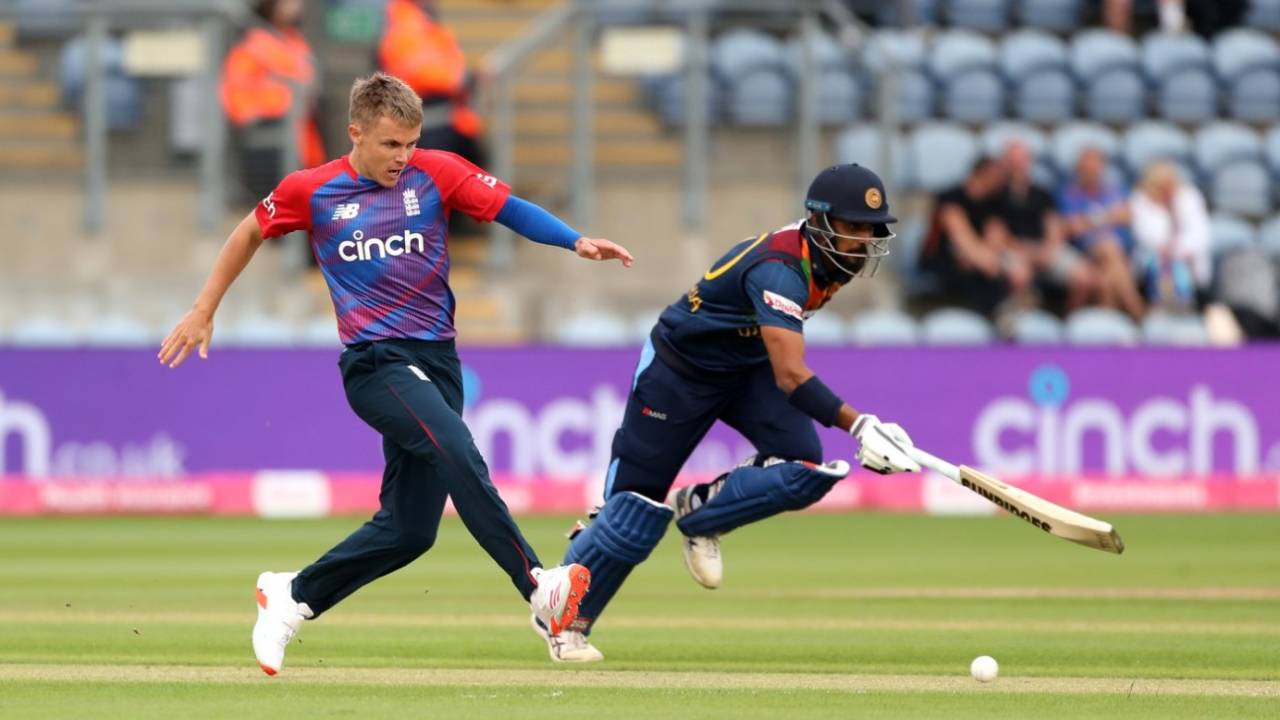If
Liam Livingstone and
Sam Billings make the cut for England's T20 World Cup squad, they will look back on tonight's second T20I in Cardiff fondly: they came together at 36 for 4 in a chase of 112 on a used, two-paced pitch and their stand of 54 in 48 balls was enough to overcome the significant wobble and lead England to a narrow win. Neither played an innings that demanded long-term retention, but between them they steered their team home from a nervous situation.
But in truth, they may be the only two of the 3,000 or so in attendance recalling this evening with much affection: England's first of two live games on free-to-air TV in the UK this summer could hardly have veered further from the script. Even with three of their most recognisable players missing through injury -
Jos Buttler strained his calf last night, with
Jofra Archer and
Ben Stokes both ruled out long before the series - they still had enough white-ball gunslingers to put on a show with the bat for a wider audience, with
Mark Wood and
Adil Rashid offering high pace and high skill in their attack. For Sri Lanka, the only way was up after a heavy defeat in the opening game.
Instead, this was a dreary occasion, with
Sam Curran providing a winning moment that it scarcely deserved by skipping down the pitch to thump Akila Dhananjaya over long-on for six. It was enough to seal a five-wicket win via the Duckworth-Lewis-Stern method - a phrase unlikely to Inspire Generations - which had looked in some peril after a rare top-order stumble. Their bowling performance was impressive and polished, but good plans and hard lengths are a tough sell to the sought-after casual fan.
Playing on this pitch for the second night in a row meant that England learned slightly more than they might have on a fresh, flat one, and with the World Cup likely to be moved to the UAE - directly after the IPL - being able to adapt to these surfaces is important. Their batting line-up is unmatched on true pitches but showed some vulnerability on the slow Ahmedabad ones earlier this year.
But there was a nagging sense that those experiences had come at the cost of the bigger picture. The break between the end of the group stages and the start of the knockouts in the ongoing European Championships opened up a priceless opportunity for English cricket, making this the night's only live, free-to-air sport in a country that has suddenly become used to a daily fix over the last two weeks. This was a clear chance to put on a show.
And while there were occasion bite-size moments to adorn social-media timelines - Curran's close-range, right-footed finish to kick the stumps down and run Danushka Gunathilaka out the prime example - anyone stumbling upon the BBC's live coverage while idly channel-surfing would have been justified in decided to switch to Channel Four's The Supervet or yet another Princess Diana documentary on ITV. There were only marginally more boundaries (16) than wickets (12), and none at all in the first powerplay as Sri Lanka struggled to adapt to the slowness of the pitch; if the Hundred is to succeed, the four match-days here cannot involve such a turgid surface.
When the rain rolled in 12 overs into the run-chase, the scene was set for the dampest squib imaginable. Mercifully, it was only a passing shower, and Livingstone suggested that its principal effect was not to interrupt his rhythm but to help the ball come onto the bat under floodlights. The revised target, 34 off 36 balls, was never going to be an issue.
Billings and Livingstone may be competing for a single spot in England's World Cup squad as the spare batter, though
Dawid Malan's lean run of form since his 99 not out in South Africa at the start of December and
Moeen Ali's continued absence suggests there could yet be room for both. They have both been on the fringes of the side for a number of years but are contrasting players: Billings prides himself on a low dot-ball percentage and an ability to hit the gaps against spin, while Livingstone is a cowboy who has made towering sixes over wide long-on his trademark.
There was no scope for them to play with any fluency or rhythm, and Billings found himself in a similar position to his last innings on this ground: a
hard-fought 30 off 30 against Glamorgan in the Blast last week which was the second-highest score in another dreary game. He struggled to pick Wanindu Hasaranga's googly - he was not the first, and certainly won't be the last - and eventually under-edged onto his own stumps for 24 off 29, but with the required rate below four an over by that stage, he had done his job.
But it was Livingstone who has pushed his credentials more than any other fringe player this week. Four years after his first taste of international cricket, a pair of T20Is against South Africa in which he looked out of form and frenetic, he has finally forced his way back in an unfamiliar finishing role. He adapted well: only six of the 26 balls he faced were dots, and an outrageous ramped six off Dushmantha Chameera effectively ended the contest after the rain delay - though the spectacle had long since vanished.

